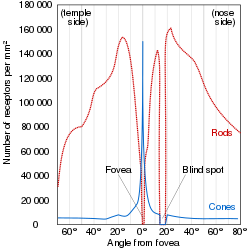Duplex retina

A duplex retina is a
Advantages
Like all sensors, photoreceptors are limited in dynamic range, i.e. the ratio between the lowest and highest signal they can detect. Having two photoreceptors of differing sensitivities can together cover more dynamic range of light. Human rods can detect 7 orders of magnitude between their minimum threshold and saturation and cones can detect 11 orders of magnitude between their minimum threshold and point of damage. However, together, considering their overlap, a human duplex retina can detect 14 orders of magnitude.[3]
For any visual system, there is a tradeoff between sensitivity and spatial/temporal acuity. A duplex retina uses two visual systems, one of which trades acuity for sensitivity (scotopic), and the other which trades sensitivity for high spatial and temporal acuity (photopic), which gives the best of both worlds.[3]
Simplex retina
Most vertebrates exhibit duplex retinas, including all major classes: mammals, birds, reptiles, bony fish, etc. However, some sub-clades will have evolved from the common vertebrate ancestor to lose one of the visual systems and develop a simplex retina, often called a pure-rod or pure-cone retina.[4] Vertebrates that have lost their cone cells and exhibit a pure-rod retina include:
- Almost 90% of deep-sea fish species are rod monochromats.[5]
- Xenarthra (armadillos, anteaters, and tree sloths)[6]
Many vertebrates have lost their rod cells and exhibit a pure-cone retinas, which include:
- most diurnal lizards[7]
- some colubrid snakes [7]
- ground squirrels were long considered to lack rod cells, but only part of the population lacks functional scotopic vision despite possessing rod cells.[8]
While most humans possess duplex retinas, some conditions lead to a failure of one of the visual systems. A human lacking cone cells and therefore a photopic system is called an achromat or rod monochromat and experiences day blindness and monochromacy. A human lacking rod cells and therefore a scotopic system has nyctalopia or night blindness.
See also
References
- ^ Gruber, Samuel H.; Gulley, Robert L.; Brandon, Janet (1 July 1975). "Duplex Retina in Seven Elasmobranch Species". Bulletin of Marine Science. 25 (3): 353–358. Archived from the original on 18 October 2021. Retrieved 18 October 2021.
- ^ "Photopic vs Scotopic Vision". isle.hanover.edu. Archived from the original on 2021-10-18. Retrieved 2021-10-18.
- ^ ISBN 9780123742032.
- PMID 27374844.
- .
- ISBN 978-3-030-81272-0.
- ^ S2CID 9077192.
- S2CID 11161113.
